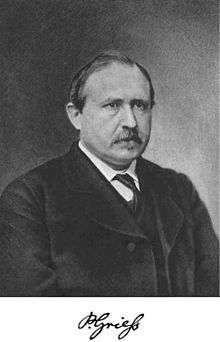Peter Griess
Johann Peter Griess (6 September 1829 – 30 August 1888) was an industrial chemist[1] and an early pioneer of organic chemistry.
Johann Peter Griess | |
|---|---|
 | |
| Born | 6 September 1829 |
| Died | 30 August 1888 (aged 58) |
| Nationality | German |
| Alma mater | University of Marburg |
| Known for | diazotization reaction |
| Scientific career | |
| Fields | Chemist |
| Institutions | University of Marburg Royal College of Chemistry |
| Doctoral advisor | Hermann Kolbe, August Wilhelm von Hofmann |
Life
After he finished at an agricultural private school, he joined the Hessian cavalry, but left the military shortly after. He started his studies at the University of Jena in 1850, but changed to the University of Marburg in 1851. During his student life he was several times sentenced to the Karzer (campus jail) and was also banned from the city for one year, during which time he listened to lectures of Justus Liebig at the Ludwig Maximilian University of Munich. After most of the family possession had been spent, he had to start working at the chemical factory of Oehler in Offenbach am Main in 1856. This was only possible after the recommendation of Hermann Kolbe, who was head of the chemistry department in Marburg. The devastating fire of 1857 ended the production of chemicals at the factory and a changed Peter Griess rejoined Hermann Kolbe at the University of Marburg. His new enthusiasm for chemistry yielded the discovery of diazonium salts in 1858.[2] The discovery of a new class of chemicals convinced August Wilhelm von Hofmann to invite Griess to join him at his new position at the Royal College of Chemistry. During his time at the Royal College, he studied the reactions of nitrogen-rich organic molecules. It took him quite long to become accustomed to his new home in England, but the fact that he married in 1869 and founded a family made it clear that he did not intend to return to Germany, even though he was offered a position at the BASF. He left and started a position at the Samuel Allsopp & Sons brewery in 1862 where he worked until his retirement. His wife died after a long, severe illness in 1886; he survived her for two years and died on August 30, 1888. He is buried in Burton upon Trent.
Work
In 1858 he described the Griess diazotization reaction which would form the basis for the Griess test for detection of Nitrite. Most of his work related to brewing remained confidential, but his additional work on organic chemistry was published by him in several articles.
Notes
- Oxford Dictionary of National Biography
- Peter Griess (1858) "Vorläufige Notiz über die Einwirkung von salpetriger Säure auf Amidinitro- und Aminitrophenylsäure," (Preliminary notice of the reaction of nitrous acid with picramic acid and aminonitrophenol), Annalen der Chemie und Pharmacie, 106 : 123-125.
References
- Griess P. (1879). "Bemerkungen zu der Abhandlung der HH. Weselky und Benedikt Ueber einige Azoverbindungen". Berichte der Deutschen Chemischen Gesellschaft. 12 (1): 426–428. doi:10.1002/cber.187901201117.
- August Bopp, August Wilhelm von Hofmann, Emil Fischer (1891). "Zur Erinnerung an Peter Griess". Berichte der Deutschen Chemischen Gesellschaft. 24 (3): 1006–1078. doi:10.1002/cber.18910240398.CS1 maint: multiple names: authors list (link)
- R. Wizinger-Aust (1958). "Peter Griess und seine Zeit". Angewandte Chemie. 70 (8): 199–204. doi:10.1002/ange.19580700802.